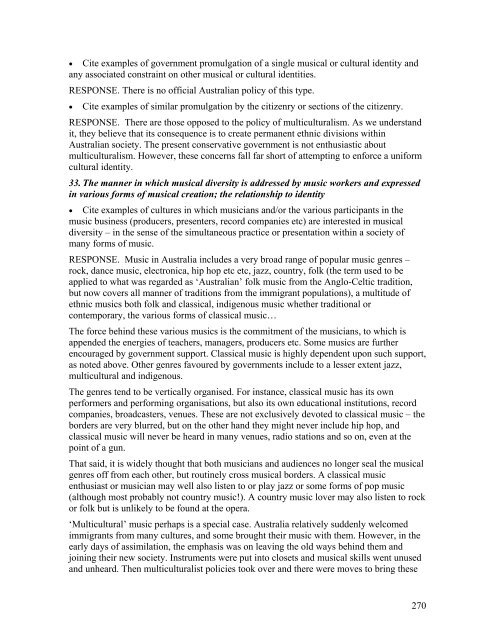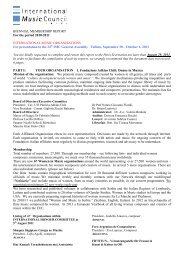Appendix 6 - International Music Council
Appendix 6 - International Music Council
Appendix 6 - International Music Council
Create successful ePaper yourself
Turn your PDF publications into a flip-book with our unique Google optimized e-Paper software.
• Cite examples of government promulgation of a single<br />
musical or cultural identity and<br />
any associated constraint on other musical or cultural identities.<br />
RESPONSE. There is no official Australian policy of this type.<br />
• Cite examples of similar promulgation by the citizenry or sections of the citizenry.<br />
RESPONSE. There are those opposed to the policy of multiculturalism. As we understand<br />
it, they believe that its consequence is to create permanent ethnic divisions within<br />
Australian society. The present conservative government is not enthusiastic about<br />
multiculturalism. However, these concerns fall far short of attempting to enforce a uniform<br />
cultural identity.<br />
33. The manner in which musical diversity is addressed by music workers and expressed<br />
in various forms of musical creation; the relationship to identity<br />
• Cite examples of cultures in which musicians<br />
and/or the various participants in the<br />
music busine ss (producers, presenters, record companies etc) are interested in musical<br />
diversity – in t he sense of the simultaneous practice or presentation within a society of<br />
many forms of music.<br />
RESPONSE. <strong>Music</strong> in Australia includes a very broad range of popular music genres –<br />
rock, dance music, electronica, hip hop etc etc, jazz, country, folk (the term used to be<br />
applied to what was regarded<br />
as ‘Australian’ folk music from the Anglo-Celtic tradition,<br />
but now covers all manner of traditions from the immigrant populations), a multitude of<br />
ethnic musics both folk and classical, indigenous music whether traditional or<br />
contemporary, the various forms of classical music…<br />
The force behind these various<br />
musics is the commitment of the musicians, to which is<br />
appended the energies of teachers,<br />
managers, producers etc. Some musics are further<br />
encouraged by government support. Classical music is highly dependent upon such support,<br />
as noted above. Other genres favoured by governments include to a lesser extent jazz,<br />
multicultural and indigenous.<br />
The genres tend to be vertically organised. For instance, classical<br />
music has its own<br />
performers and performing organisations, but also its own educational institutions, record<br />
companies, broadcasters, venues. These are not exclusively devoted to classical music – the<br />
borders are very blurred, but on the other hand they might never include hip hop, and<br />
classical music will never be heard in many venues, radio stations and so on, even at the<br />
point of a gun.<br />
That said, it is widely thought that both musicians and audiences no longer seal the musical<br />
genres off from each other, but routinely cross musical borders. A classical music<br />
enthusiast or musician may well also listen to or play jazz or some forms of pop music<br />
(although most probably not country music!). A country music lover may also listen to rock<br />
or folk but is unlikely to be found at the opera.<br />
‘Multicultural’ music perhaps is a special case. Australia relatively suddenly welcomed<br />
immigrants from many cultures, and some brought their music with them. However,<br />
in the<br />
early days of assimilation, the emphasis was on leaving the old ways behind them and<br />
joining their new society. Instruments were put into closets and musical skills<br />
went unused<br />
and unheard. Then multiculturalist policies took over and there were moves to bring these<br />
270



